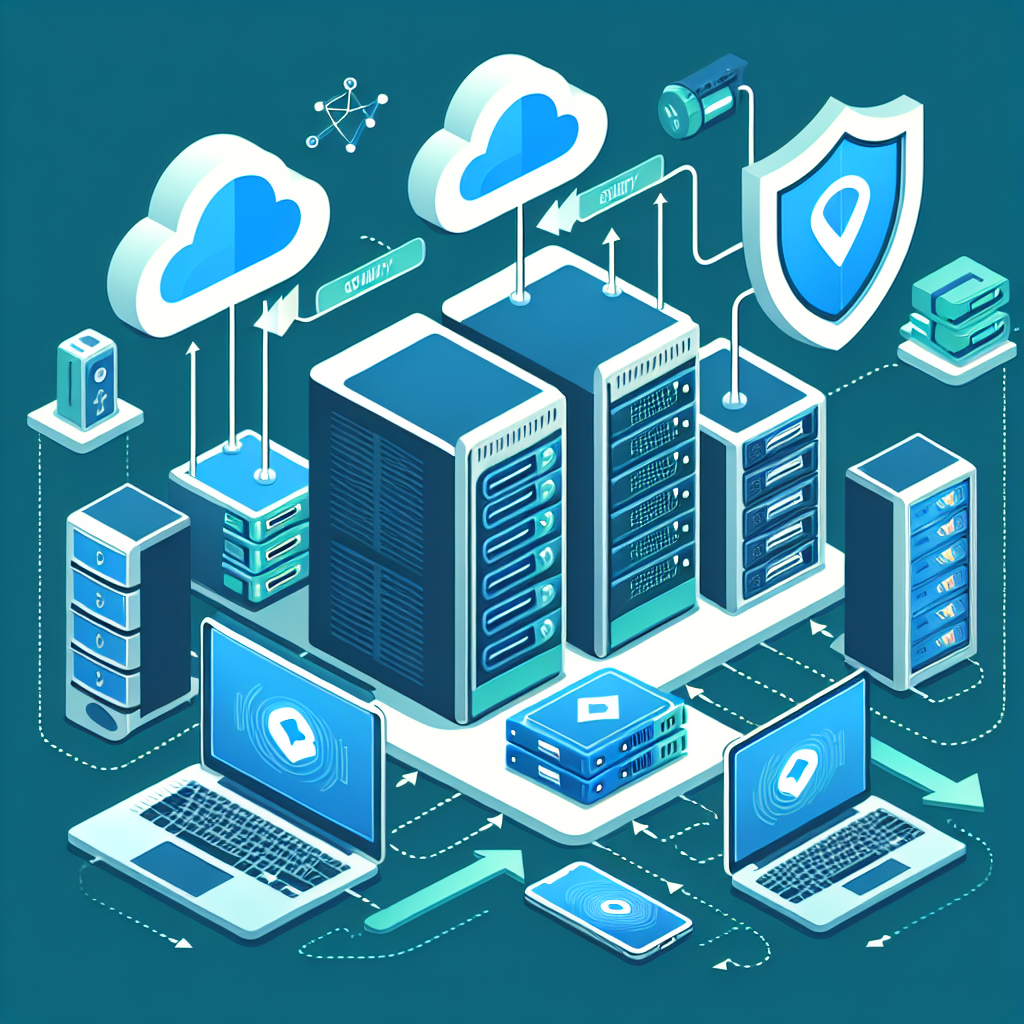Your cart is currently empty!
Tag: Organization

Building a Culture of Preparedness: Promoting Business Continuity Awareness in Your Organization
In today’s fast-paced and unpredictable business environment, it is crucial for organizations to prioritize and invest in building a culture of preparedness. This involves promoting awareness and understanding of business continuity planning and ensuring that all employees are equipped to respond effectively to any potential disruptions or crises.Business continuity planning is the process of developing and implementing strategies and measures to ensure that essential business functions can continue in the event of a disruption. This can include natural disasters, cyber-attacks, pandemics, or any other unforeseen events that could impact the organization’s operations.
One of the key components of building a culture of preparedness is promoting awareness and education about business continuity planning within the organization. This involves educating employees at all levels about the importance of being prepared for potential disruptions and the role they can play in ensuring business continuity.
Organizations can promote awareness by conducting regular training sessions, workshops, and drills to familiarize employees with the organization’s business continuity plan and procedures. These sessions should cover topics such as emergency response protocols, communication strategies, and the importance of having backup systems in place.
In addition to training sessions, organizations can also use communication channels such as emails, newsletters, and intranet portals to keep employees informed about business continuity planning efforts and provide updates on any changes or updates to the plan.
Building a culture of preparedness also involves fostering a mindset of resilience and adaptability within the organization. This means encouraging employees to be proactive in identifying potential risks and vulnerabilities, as well as empowering them to take ownership of their role in ensuring business continuity.
Organizations can also incentivize and reward employees who demonstrate a commitment to preparedness and actively contribute to the organization’s business continuity efforts. This can help create a sense of accountability and motivation among employees to prioritize and invest in preparedness.
Ultimately, building a culture of preparedness is essential for organizations to effectively respond to and recover from disruptions. By promoting awareness and understanding of business continuity planning, organizations can ensure that they are better equipped to navigate challenges and uncertainties, safeguard their operations, and protect their employees and stakeholders.

How to Create a Strong Cybersecurity Culture in Your Organization
In today’s digital age, cybersecurity has become a critical concern for organizations of all sizes. With cyber threats constantly evolving and becoming more sophisticated, it is essential for businesses to create a strong cybersecurity culture to protect their sensitive data and information. A strong cybersecurity culture not only helps in preventing cyber attacks but also ensures that employees are aware of the potential risks and are equipped with the necessary tools and knowledge to mitigate them.Here are some tips on how to create a strong cybersecurity culture in your organization:
1. Invest in cybersecurity training: One of the most important steps in creating a strong cybersecurity culture is to provide comprehensive training to all employees. This training should cover topics such as identifying phishing emails, creating strong passwords, and recognizing potential security threats. Regular training sessions should be conducted to keep employees up-to-date with the latest cybersecurity best practices.
2. Implement strict security policies: It is essential to have clear and strict security policies in place to govern how employees should handle sensitive data and information. These policies should outline the procedures for accessing and sharing data, using company devices, and reporting any security incidents. Regular audits should be conducted to ensure that employees are complying with these policies.
3. Encourage a culture of accountability: Employees should be encouraged to take responsibility for their actions and be held accountable for any security breaches that occur due to negligence or errors. By promoting a culture of accountability, employees will be more vigilant in following security protocols and reporting any suspicious activities.
4. Foster open communication: It is important to create an environment where employees feel comfortable reporting security incidents or raising concerns about potential threats. Open communication channels, such as a dedicated cybersecurity hotline or email address, should be established to enable employees to report any security issues without fear of reprisal.
5. Lead by example: The leadership team plays a crucial role in setting the tone for cybersecurity culture within an organization. Leaders should demonstrate a commitment to cybersecurity by following best practices themselves and actively promoting a culture of security awareness among employees.
6. Conduct regular security assessments: Regular security assessments, such as penetration testing and vulnerability scanning, should be conducted to identify any weaknesses in your organization’s security infrastructure. These assessments will help in identifying potential vulnerabilities and taking proactive measures to address them before they can be exploited by cybercriminals.
By following these tips, organizations can create a strong cybersecurity culture that will help in protecting their sensitive data and information from cyber threats. Remember, cybersecurity is not just the responsibility of the IT department – it is a collective effort that requires the participation of every employee in the organization. By fostering a culture of security awareness and vigilance, organizations can minimize the risk of cyber attacks and safeguard their valuable assets.

Data Backup and Recovery Solutions: Finding the Right Fit for Your Organization
In today’s digital age, data is the lifeblood of any organization. From customer information to financial records, businesses rely on data to make strategic decisions and drive growth. However, data loss can happen in an instant due to a variety of factors such as human error, hardware failure, cyber attacks, or natural disasters. That’s why having a reliable data backup and recovery solution in place is crucial for any organization.Data backup and recovery solutions are designed to protect your data by creating copies of it and storing them in a secure location. In the event of data loss, these solutions allow you to quickly recover your data and minimize downtime. But with a plethora of options available in the market, finding the right fit for your organization can be a daunting task. Here are some factors to consider when choosing a data backup and recovery solution:
1. Scalability: As your organization grows, so does your data. It’s important to choose a solution that can easily scale to meet your changing storage needs without compromising performance.
2. Reliability: Look for a solution that offers reliable backup and recovery capabilities. This includes features such as regular backups, encryption, and automated recovery processes.
3. Compatibility: Make sure the solution is compatible with your existing systems and software. It should seamlessly integrate with your IT infrastructure to ensure a smooth backup and recovery process.
4. Cost-effectiveness: Consider the cost of the solution, including upfront costs, ongoing maintenance fees, and potential hidden costs. Choose a solution that offers a good balance between cost and features.
5. Security: Data security is paramount. Ensure the solution you choose offers robust security measures to protect your data from unauthorized access or cyber attacks.
6. Ease of use: Look for a solution that is user-friendly and easy to manage. A complex solution that requires extensive training to use may not be the best fit for your organization.
7. Support: Choose a vendor that offers reliable customer support and technical assistance. In the event of a data loss, you should be able to quickly reach out to the vendor for help.
Ultimately, the right data backup and recovery solution for your organization will depend on your specific needs and budget. It’s important to carefully evaluate your options and choose a solution that offers the best combination of features, reliability, and cost-effectiveness. By investing in a reliable data backup and recovery solution, you can ensure the safety and security of your organization’s most valuable asset – its data.

Maximizing the Value of Technical Support for Your Organization
In today’s fast-paced and technology-driven business world, technical support plays a crucial role in ensuring the smooth operation of an organization’s IT infrastructure. Whether it’s resolving hardware or software issues, troubleshooting network problems, or providing guidance on best practices, technical support teams are the unsung heroes that keep businesses up and running.However, many organizations fail to realize the full potential of their technical support teams and end up underutilizing this valuable resource. To maximize the value of technical support for your organization, it’s essential to adopt a proactive approach and implement strategies that foster collaboration, communication, and continuous improvement.
Here are some tips to help you get the most out of your technical support team:
1. Invest in training and development: Technical support is a constantly evolving field, with new technologies and tools being introduced all the time. To ensure that your team is equipped to handle any challenges that come their way, invest in ongoing training and development programs. This will not only help them stay up-to-date on the latest trends and best practices but also boost their confidence and morale.
2. Foster a culture of collaboration: Technical support teams often work in silos, with each member focusing on their own tasks and responsibilities. To maximize their effectiveness, encourage collaboration and knowledge sharing among team members. This can be done through regular team meetings, brainstorming sessions, and cross-training opportunities. By working together, your team can leverage each other’s strengths and experiences to solve problems more efficiently.
3. Implement a ticketing system: Keeping track of technical issues and requests can be overwhelming, especially in a fast-paced environment. Implementing a ticketing system can help streamline the support process by organizing and prioritizing incoming requests. This not only ensures that no request falls through the cracks but also provides valuable data for analyzing trends and identifying areas for improvement.
4. Provide feedback and recognition: Technical support can be a thankless job, with team members often working behind the scenes to keep things running smoothly. To boost morale and motivation, provide regular feedback and recognition for their hard work and dedication. This can be as simple as a shout-out in a team meeting or a small token of appreciation. By showing your team that their efforts are valued, you can create a positive work environment that fosters loyalty and engagement.
5. Encourage continuous improvement: Technical support is a dynamic field, with new challenges and opportunities arising all the time. Encourage your team to continuously seek out ways to improve their skills and processes. This can be done through regular performance reviews, feedback sessions, and training opportunities. By fostering a culture of continuous improvement, you can ensure that your technical support team is always at the top of their game.
In conclusion, maximizing the value of technical support for your organization requires a proactive approach and a commitment to ongoing improvement. By investing in training and development, fostering collaboration, implementing a ticketing system, providing feedback and recognition, and encouraging continuous improvement, you can harness the full potential of your technical support team and keep your organization running smoothly.

Mitigating Risk: Why Every Organization Needs a Disaster Recovery Strategy
Disasters can strike at any time, whether it be a natural disaster like a hurricane or earthquake, or a man-made disaster such as a cyber attack or system failure. These events can have devastating consequences for businesses, causing loss of data, revenue, and even reputation.That is why every organization needs a disaster recovery strategy in place to mitigate the risks associated with such events. A disaster recovery strategy is a plan that outlines how an organization will respond to and recover from a disaster, ensuring that critical business functions can continue operating even in the face of adversity.
One of the key reasons why every organization needs a disaster recovery strategy is to minimize the impact of a disaster on the business. By having a plan in place, organizations can quickly assess the situation, prioritize recovery efforts, and take action to minimize downtime and loss of data. This can help to reduce the financial impact of a disaster and ensure that the organization can quickly recover and resume normal operations.
Another important reason for having a disaster recovery strategy is to protect the organization’s reputation. In today’s digital age, news of a disaster can spread quickly, and a poorly managed response can damage the organization’s reputation and erode customer trust. By having a well-thought-out disaster recovery strategy, organizations can demonstrate their commitment to their customers and stakeholders, and show that they are prepared for any eventuality.
A disaster recovery strategy can also help organizations comply with regulatory requirements and industry standards. Many industries have regulations in place that require organizations to have a plan in place to protect their data and ensure business continuity in the event of a disaster. By having a disaster recovery strategy, organizations can demonstrate compliance with these regulations and avoid potential fines or penalties.
In conclusion, every organization needs a disaster recovery strategy to mitigate the risks associated with disasters. By having a plan in place, organizations can minimize the impact of a disaster, protect their reputation, comply with regulations, and ensure that critical business functions can continue operating even in the face of adversity. Investing in a disaster recovery strategy is essential for the long-term success and resilience of any organization.

Best Practices for Network Management in a Growing Organization
As an organization grows, so does its network infrastructure. With more employees, devices, and applications accessing the network, managing and maintaining it becomes increasingly complex. To ensure optimal performance and security, it is essential for growing organizations to implement best practices for network management. Here are some key strategies to consider:1. Regular network monitoring and performance analysis: Continuous monitoring of network traffic, bandwidth usage, and performance metrics is crucial for identifying and troubleshooting issues before they escalate. Utilize network management tools to track and analyze data in real-time, allowing you to proactively address any potential bottlenecks or security threats.
2. Scalability and flexibility: As your organization expands, your network must be able to accommodate additional users and devices without compromising performance. Implementing a scalable network architecture that can easily adapt to changing needs will ensure seamless growth and efficiency.
3. Network segmentation: Segmenting your network into separate virtual LANs (VLANs) based on departments, functions, or security requirements can help improve network efficiency and security. By isolating traffic and controlling access between segments, you can minimize the risk of unauthorized access and potential data breaches.
4. Security measures: Implementing robust security measures, such as firewalls, intrusion detection systems, and encryption protocols, is essential for safeguarding your network against cyber threats. Regular security audits and updates will help identify vulnerabilities and ensure compliance with industry regulations.
5. Disaster recovery and backup solutions: In the event of a network outage or data loss, having a comprehensive disaster recovery plan in place is essential for minimizing downtime and data loss. Regularly backing up critical data and implementing redundant systems will help ensure business continuity and resilience.
6. Employee training and awareness: Educating employees about network security best practices and protocols is crucial for preventing human error and potential security breaches. Conduct regular training sessions and provide clear guidelines for handling sensitive information and accessing the network securely.
7. Vendor management: Establishing strong relationships with network equipment vendors and service providers can help ensure timely support and maintenance for your network infrastructure. Regularly review service level agreements and performance metrics to hold vendors accountable for delivering quality services.
By implementing these best practices for network management, growing organizations can effectively optimize performance, enhance security, and support future growth. Investing in a robust network infrastructure and proactive management strategies will enable your organization to stay competitive and resilient in an increasingly digital world.

How IT Solutions Can Drive Digital Transformation in Your Organization
In today’s fast-paced and technology-driven world, digital transformation has become a necessity for businesses looking to stay competitive and relevant in the market. With the rapid advancements in technology, organizations need to adapt and evolve to keep up with the ever-changing landscape. One of the key drivers of digital transformation is the implementation of IT solutions that can help streamline processes, improve efficiency, and enhance overall productivity.IT solutions play a crucial role in driving digital transformation within an organization. These solutions encompass a wide range of technologies and tools that are designed to automate tasks, improve communication, and optimize business operations. From cloud computing and data analytics to cybersecurity and artificial intelligence, IT solutions can revolutionize the way businesses operate and interact with customers.
One of the main benefits of IT solutions in digital transformation is their ability to enhance efficiency and productivity. By automating repetitive tasks and streamlining processes, organizations can reduce manual errors, save time, and improve overall productivity. For example, implementing a customer relationship management (CRM) system can help businesses better manage customer interactions, track sales leads, and improve customer service.
IT solutions also enable organizations to make data-driven decisions by providing valuable insights and analytics. By harnessing the power of big data and analytics tools, businesses can gain a deeper understanding of their customers, market trends, and competition. This data-driven approach can help organizations identify new opportunities, optimize strategies, and drive business growth.
Furthermore, IT solutions can help organizations improve collaboration and communication among employees. With the rise of remote work and distributed teams, having the right tools in place is essential for seamless communication and collaboration. From video conferencing and project management platforms to instant messaging and file sharing tools, IT solutions can facilitate better communication and teamwork within the organization.
In addition, IT solutions play a critical role in enhancing cybersecurity and protecting sensitive business data. With the increasing number of cyber threats and data breaches, organizations need to prioritize cybersecurity to safeguard their assets and reputation. By implementing robust cybersecurity measures such as firewalls, encryption, and threat detection systems, businesses can mitigate risks and ensure the security of their digital assets.
Overall, IT solutions are essential for driving digital transformation within an organization. By leveraging technology to automate processes, improve efficiency, and enhance communication, businesses can stay ahead of the curve and thrive in today’s digital age. Whether it’s implementing cloud computing, data analytics, or cybersecurity solutions, organizations need to embrace IT solutions to adapt to the changing business landscape and stay competitive in the market.

Why Data Backup and Recovery Should be a Priority for Every Organization
In today’s digital age, data is one of the most valuable assets that organizations possess. From customer information and financial records to intellectual property and business strategies, data plays a crucial role in the success and operations of every organization. However, with the increasing threat of cyber attacks, natural disasters, and human error, the risk of losing this valuable data is higher than ever. This is why data backup and recovery should be a top priority for every organization.Data backup refers to the process of making copies of data and storing them in a secure location. This ensures that in the event of a data loss incident, such as a cyber attack or hardware failure, organizations can quickly recover their data and resume their operations. Without a proper data backup system in place, organizations risk losing critical information that could have devastating consequences on their business.
Data recovery, on the other hand, is the process of retrieving lost or corrupted data from backups. This is essential for organizations to minimize downtime and ensure business continuity in the face of data loss incidents. By having a robust data recovery plan in place, organizations can quickly restore their data and systems to normal functioning, reducing the impact of data loss on their operations.
There are several reasons why data backup and recovery should be a priority for every organization. Firstly, data loss incidents can happen at any time and in various forms, such as cyber attacks, natural disasters, hardware failures, and human error. Without a proper backup and recovery system in place, organizations risk losing critical data and facing significant financial and reputational damage.
Secondly, data backup and recovery are essential for regulatory compliance. Many industries have strict data protection regulations that require organizations to have proper backup and recovery measures in place to safeguard sensitive information. Failure to comply with these regulations can result in hefty fines and legal consequences for organizations.
Additionally, data backup and recovery are essential for business continuity. In today’s fast-paced business environment, downtime is costly and can have a significant impact on an organization’s bottom line. By having a reliable backup and recovery system in place, organizations can minimize downtime and ensure that their operations continue uninterrupted in the face of data loss incidents.
In conclusion, data backup and recovery should be a top priority for every organization. With the increasing threat of data loss incidents, organizations must take proactive measures to safeguard their valuable data and ensure business continuity. By implementing a robust data backup and recovery system, organizations can protect their data, comply with regulations, and minimize the impact of data loss on their operations. It is essential for organizations to invest in data backup and recovery solutions to safeguard their most valuable asset – their data.

How Outsourcing IT Infrastructure Management Can Benefit Your Organization
In today’s digital age, technology plays a crucial role in the success of any organization. From managing day-to-day operations to connecting with customers, having a reliable IT infrastructure is essential for businesses to thrive. However, maintaining and managing IT infrastructure can be a complex and time-consuming task, especially for small and medium-sized enterprises.This is where outsourcing IT infrastructure management can offer numerous benefits to organizations. By partnering with a reputable IT services provider, businesses can access a wide range of expertise and resources that can help streamline operations, improve efficiency, and boost productivity.
One of the key benefits of outsourcing IT infrastructure management is cost savings. By outsourcing IT services, organizations can eliminate the need to invest in expensive hardware, software, and IT personnel. Instead, they can pay a fixed monthly fee for the services they need, allowing them to better manage their IT budget and allocate resources to other areas of the business.
Outsourcing IT infrastructure management also allows organizations to access a team of highly skilled and experienced professionals who can provide round-the-clock support and proactive monitoring of the IT systems. This can help prevent potential issues before they occur, minimizing downtime and ensuring that the business operations run smoothly.
Furthermore, outsourcing IT infrastructure management can also help businesses stay up-to-date with the latest technologies and trends. IT services providers are constantly updating their skills and knowledge to keep pace with the rapidly evolving IT landscape, ensuring that their clients have access to the most innovative solutions and technologies.
Additionally, outsourcing IT infrastructure management can help organizations improve their security posture. IT services providers have robust security measures in place to protect their clients’ data and systems from cyber threats. By outsourcing IT management, businesses can benefit from enhanced security protocols and compliance with industry regulations.
In conclusion, outsourcing IT infrastructure management can offer numerous benefits to organizations of all sizes. From cost savings and access to expertise to improved security and efficiency, partnering with a reputable IT services provider can help businesses focus on their core competencies and achieve their business goals. If you’re looking to streamline your IT operations and enhance your organization’s performance, consider outsourcing IT infrastructure management today.

Building a Strong Foundation: Why Business Continuity is Essential for Every Organization
In today’s fast-paced and ever-changing business environment, it is crucial for organizations to have a strong foundation in place to ensure their survival and success. One key component of this foundation is business continuity planning.Business continuity planning is the process of developing a plan to ensure that an organization can continue to operate in the event of a disruption or disaster. This could be anything from a natural disaster, such as a hurricane or earthquake, to a cyber-attack or power outage. By having a solid business continuity plan in place, organizations can minimize the impact of these disruptions and ensure that they can continue to serve their customers and meet their obligations.
There are several reasons why business continuity is essential for every organization. First and foremost, it helps to protect the organization’s reputation and brand. In today’s digital age, news of a disruption or disaster can spread quickly, and if an organization is unable to recover quickly and effectively, it can damage its reputation and lead to a loss of customers and revenue. By having a business continuity plan in place, organizations can show their customers and stakeholders that they are prepared for any eventuality and can continue to operate effectively in the face of adversity.
Secondly, business continuity planning can help organizations comply with regulatory requirements. Many industries have strict regulations in place that require organizations to have a business continuity plan in place to ensure the safety and security of their operations. By having a plan in place, organizations can demonstrate their commitment to compliance and avoid potential fines and penalties.
Finally, business continuity planning can help organizations save time and money in the long run. By having a plan in place, organizations can reduce the amount of downtime they experience in the event of a disruption, which can lead to significant financial losses. Additionally, having a plan in place can help organizations prioritize their recovery efforts and ensure that they are able to resume operations as quickly as possible.
In conclusion, building a strong foundation for your organization is essential for long-term success, and business continuity planning is a key component of that foundation. By having a plan in place, organizations can protect their reputation, comply with regulatory requirements, and save time and money in the event of a disruption. If your organization does not already have a business continuity plan in place, now is the time to start developing one. Your organization’s survival may depend on it.
